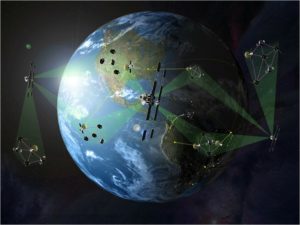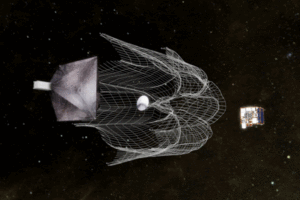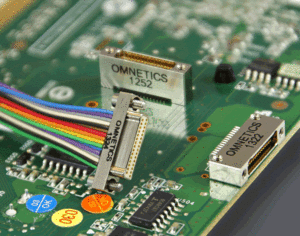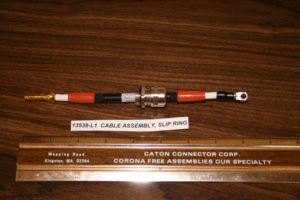Connectors Ace the Space Race
Supremely durable space-grade connectors help us explore the next frontier.
By Caroline Hayes
 Today, thousands of commercial satellites circle the globe to enable the telecommunications needed to implement the Internet of Things. They are also used for navigation systems and research projects, like the European Space Agency’s Galileo global navigation satellite system (GNSS) and Copernicus, the European Union’s Earth Observation Program, which will reach their full operational stages in the next few years.
Today, thousands of commercial satellites circle the globe to enable the telecommunications needed to implement the Internet of Things. They are also used for navigation systems and research projects, like the European Space Agency’s Galileo global navigation satellite system (GNSS) and Copernicus, the European Union’s Earth Observation Program, which will reach their full operational stages in the next few years.
The rigors of space require a specific set of performance parameters for connectors, as they have to withstand extreme environments and meet strict space and weight parameters.
Space Factors
“As with any mission-critical application, high degrees of operational robustness are obviously mandated due to exposure to challenging external environments,” said Ben Green, head of new business at Harwin. “Likewise, the weight of the constituent components must be kept in check, so they do not add to the payload and thereby impact fuel consumption during launch. Board real estate is also at a premium, with heavily populated PCBs all stacked closely together. Consequently, high contact density is another important attribute.”
For Bob Stanton, director, Omnetics, the key to connector and cable designs for space is to focus on miniaturized rugged reliability. “The combined interconnect systems must be focused on more than just the connector,” he says. “Form and fit follow quickly behind the reliability factors, as we see more and more designs being crammed into smaller and smaller unique spaces and configurations.”
The type of pin to socket system is also important, says Stanton. It has to provide continuous signal performance through high shock, together with noise-free contacts during long durations of vibration and sinusoidal wave induced vibration cycles. To manage the extremes of temperature, the materials used have to have similar coefficients of expansion and compression.
Another consideration is that vacuum conditions can affect a connector assembly’s circuitry. “Connectors can be prone to varying levels of outgassing if they are placed in a vacuum,” said Green. “This can have a detrimental effect on the performance of critical electronic circuitry in the vicinity, and even has the potential to cause failure.”

Figure 1: Components from Harwin’s Gecko series have been designed into hardware for nanosatellite constellation projects, such as the Surrey Space Centre CubeSat project to remove space junk from the Earth’s orbit.
In response, both companies only use materials that have been tested by NASA. The standardized test procedure called ASTM E 595 evaluates the outgassing properties of polymers. Small samples of materials are heated up to 125°C (257°F) at a vacuum of 5´10-5 torr for 24 hours. At that point, samples are weighed to calculate the total mass loss (TML). The TML cannot exceed 1.00% of the total initial mass, explains Stanton. During the test, outgassed matter condenses on a cooled collector plate and the quantity of outgassed matter is calculated to determine the collected volatile condensable material (CVCM).
Only connectors and cables that use polymer materials from the NASA-approved list can qualify as a space-grade connector assembly.
Most space-certified connector companies offer NASA screening per EEE-INST-002, within which there are specific instructions for nanominiature connectors. This exceeds the requirements of ML-DTL-32139 inspection, says Stanton. NASA defines three levels of screening: Level 1 for applications deemed mission-critical, Level 2 for high reliability, and Level 3 for standard reliability.

Figure 2: Saving board space and reducing weight are criteria for Omnetics’ connector design.
Omnetics’ standard connectors use NASA materials and its space-grade, 0.25” (6.35mm) pitch Nano-D connectors are the smallest space-grade connectors on the market, says Stanton. “Nano-D connectors have reduced size and weight by as much as four times that of standard micro-D connector and eight times that of previous D-sub footprints,” he says. “The Mars Rover is designed with Omnetics Strip connectors to save space and weight.”
Harwin’s Gecko connectors have been used in commercial space ventures, said Green, as well as in research work. “They are designed into hardware for nanosatellite constellation projects and spacecraft that will be tasked with removing the growing quantities of space junk from the Earth’s orbit,” he said. The 0.05” (1.25mm) pitch connectors can deal with extreme levels of temperature, shock, and vibration, are lightweight due to their plastic shells, take up minimal board space, and have strong outgassing characteristics. The Datamate offering is also robust and compact, and has the added advantage of a broader spectrum of configuration options, for greater space savings.
High-Voltage Design
A particular phenomenon that connectors used in satellite design is face is corona, a high-voltage electrical discharge. However, how and when these electrical discharges occur remains unknown. Caton Connector offers a non-corona connector that is suitable for space as well as mil/aero and medical applications. Keith Rooney, a manufacturing/design engineer at Caton, explains that some modifications are needed when specifying its connector in a space application. “Earth’s lower-pressure environment reduces the amount of voltage required to induce corona,” he said. “Increased corona discharges could break down the dielectric causing eventual failure.”

Figure 3: A Caton connector designed to operate at high altitude.
Trying to achieve higher voltages in a smaller package is a challenge, due to the size and weight constraints of space connectors, said Rooney. “One of the ways we can maintain the voltage requirement without increasing the size of the connector is through the use of our customized inserts with conical noses, which have been designed to evacuate the air at the interface while being mated.”
The inserts compress together and form an airtight seal, which allows a greater voltage to be applied without the use of gaskets. These inserts are custom on most of the company’s standard products.
Products like these are enabling designers to develop products for use in space that can go further, last longer, and transmit more vital information back to Earth. The space race is still delivering innovation, thanks to the latest space-grade connectors.





